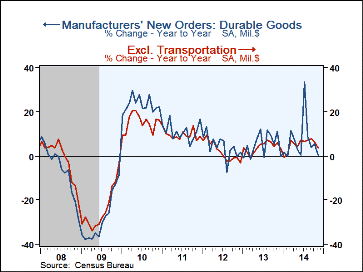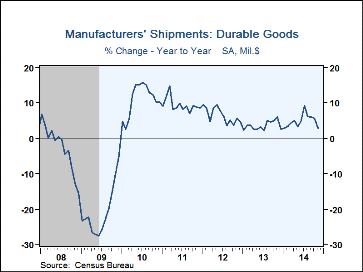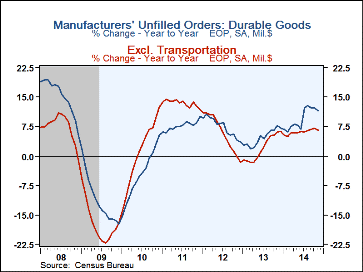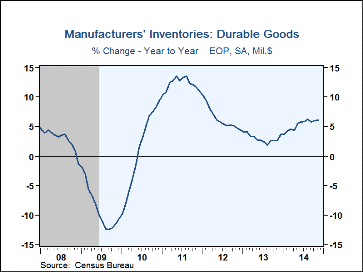 Global| Dec 23 2014
Global| Dec 23 2014U.S. Durable Goods Orders Show Unexpected Decline
Summary
New orders for durable goods fell 0.7% in November (+0.3% y/y) after rising 0.3% in October, which was marginally revised from 0.4%. The November decline confounded expectations for a 3.0% gain in the Action Economics Forecast Survey. [...]
New orders for durable goods fell 0.7% in November (+0.3% y/y) after rising 0.3% in October, which was marginally revised from 0.4%. The November decline confounded expectations for a 3.0% gain in the Action Economics Forecast Survey. The defense aircraft sector, which had supported orders in October, decreased in the latest month, along with several other industries.
Defense aircraft fell back 7.8% in November (+29.9% y/y), after their 43.5% bounce in October. Overall transportation sector orders fell 1.2% (-6.7% y/y) and total durable goods orders excluding transportation were still down, by 0.4% (+3.9% y/y) after a 1.0% decline in September. Among transportation equipment industries other than defense aircraft, motor vehicles and parts were up 0.2% (-0.7% y/y), after a 0.6% rise in October. Nondefense aircraft orders rose 0.6% m/m but were down 28.5% y/y; they had risen 0.8% in October.
Orders in other sectors were mostly down again last month. Primary metals orders fell 1.4% (3.2% y/y), after their October decline of 1.8%. Fabricated metal products were down 0.6% (+8.2% y/y) in November after a 0.3% October increase. Computer and electronics products orders fell 1.8% (-1.7% y/y) after a slim 0.1% rise. "All other" durable goods were off 0.1% (+6.9% y/y) after a 0.4% fall the previous month.
Machinery orders were an exception, gaining 0.9% in November (0.8% y/y), a partial rebound from their October drop of 2.0%. Electrical machinery and appliance orders were flat in November (6.2% y/y) after a 4.0% drop in October.
Durable goods shipments fell 0.4% last month (2.9% y/y) after their modest 0.1% fall in October, revised from +0.1%. Excluding transportation equipment, shipments were off 0.1% (+4.4% y/y) after a 0.3% decline. Total order backlogs rose 0.4% (+11.6% y/y) in November, after a 0.5% increase the month before. Excluding transportation, backlogs were up 0.3% (+6.6% y/y) after a 0.4% increase. Durable goods inventories rose 0.4% (+6.2% y/y), the same as a slightly revised October increase. Excluding the transportation sector, inventories were up 0.2% (4.3% y/y) in each November and October.
The durable goods figures are available in Haver's USECON database. The Action Economics consensus forecast figure is in the AS1REPNA database.
| Durable Goods NAICS Classification | Nov | Oct | Sep | Y/Y | 2013 | 2012 | 2011 |
|---|---|---|---|---|---|---|---|
| New Orders (SA, %) | -0.7 | 0.3 | -0.7 | 0.3 | 5.2 | 4.1 | 11.0 |
| Transportation | -1.2 | 3.3 | -3.1 | -6.7 | 7.9 | 8.9 | 14.9 |
| Total Excluding Transportation | -0.4 | -1.0 | 0.3 | 3.9 | 4.0 | 2.1 | 9.5 |
| Nondefense Capital Goods | 0.5 | -0.1 | -4.8 | -5.5 | 8.7 | 3.7 | 15.3 |
| Excluding Aircraft | 0.0 | -1.9 | -1.1 | 1.8 | 5.0 | 2.1 | 11.6 |
| Shipments | -0.4 | -0.1 | 0.3 | 2.9 | 3.7 | 6.4 | 9.4 |
| Inventories | 0.4 | 0.4 | 0.5 | 6.2 | 3.8 | 4.5 | 10.8 |
| Unfilled Orders | 0.4 | 0.5 | 0.4 | 11.6 | 7.0 | 3.6 | 10.0 |
Carol Stone, CBE
AuthorMore in Author Profile »Carol Stone, CBE came to Haver Analytics in 2003 following more than 35 years as a financial market economist at major Wall Street financial institutions, most especially Merrill Lynch and Nomura Securities. She has broad experience in analysis and forecasting of flow-of-funds accounts, the federal budget and Federal Reserve operations. At Nomura Securites, among other duties, she developed various indicator forecasting tools and edited a daily global publication produced in London and New York for readers in Tokyo. At Haver Analytics, Carol is a member of the Research Department, aiding database managers with research and documentation efforts, as well as posting commentary on select economic reports. In addition, she conducts Ways-of-the-World, a blog on economic issues for an Episcopal-Church-affiliated website, The Geranium Farm. During her career, Carol served as an officer of the Money Marketeers and the Downtown Economists Club. She has a PhD from NYU's Stern School of Business. She lives in Brooklyn, New York, and has a weekend home on Long Island.









